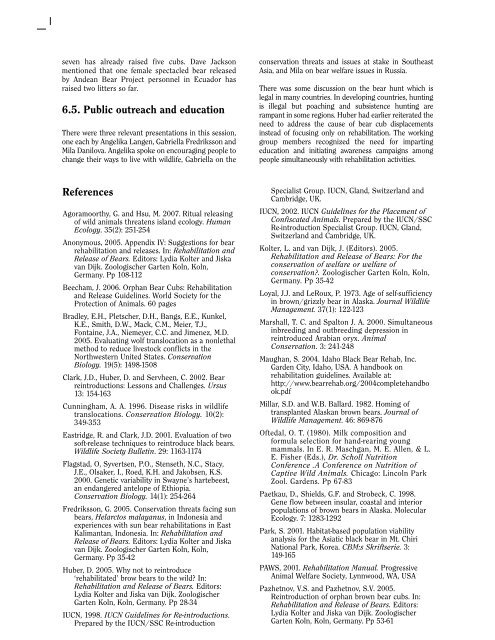Walking The Bears.pdf
Walking The Bears.pdf
Walking The Bears.pdf
- TAGS
- walking
- www.ifaw.org
Create successful ePaper yourself
Turn your PDF publications into a flip-book with our unique Google optimized e-Paper software.
seven has already raised five cubs. Dave Jackson<br />
mentioned that one female spectacled bear released<br />
by Andean Bear Project personnel in Ecuador has<br />
raised two litters so far.<br />
6.5. Public outreach and education<br />
<strong>The</strong>re were three relevant presentations in this session,<br />
oneeachbyAngelikaLangen,GabriellaFredrikssonand<br />
MilaDanilova.Angelikaspokeonencouragingpeopleto<br />
change their ways to live with wildlife, Gabriella on the<br />
References<br />
Agoramoorthy, G. and Hsu, M. 2007. Ritual releasing<br />
of wild animals threatens island ecology. Human<br />
Ecology. 35(2): 251-254<br />
Anonymous, 2005. Appendix IV: Suggestions for bear<br />
rehabilitation and releases. In: Rehabilitation and<br />
Release of <strong>Bears</strong>. Editors: Lydia Kolter and Jiska<br />
van Dijk. Zoologischer Garten Koln, Koln,<br />
Germany. Pp 108-112<br />
Beecham, J. 2006. Orphan Bear Cubs: Rehabilitation<br />
and Release Guidelines. World Society for the<br />
Protection of Animals. 60 pages<br />
Bradley, E.H., Pletscher, D.H., Bangs, E.E., Kunkel,<br />
K.E., Smith, D.W., Mack, C.M., Meier, T.J.,<br />
Fontaine, J.A., Niemeyer, C.C. and Jimenez, M.D.<br />
2005. Evaluating wolf translocation as a nonlethal<br />
method to reduce livestock conflicts in the<br />
Northwestern United States. Conservation<br />
Biology. 19(5): 1498-1508<br />
Clark, J.D., Huber, D. and Servheen, C. 2002. Bear<br />
reintroductions: Lessons and Challenges. Ursus<br />
13: 154-163<br />
Cunningham, A. A. 1996. Disease risks in wildlife<br />
translocations. Conservation Biology. 10(2):<br />
349-353<br />
Eastridge, R. and Clark, J.D. 2001. Evaluation of two<br />
soft-release techniques to reintroduce black bears.<br />
Wildlife Society Bulletin. 29: 1163-1174<br />
Flagstad, O, Syvertsen, P.O., Stenseth, N.C., Stacy,<br />
J.E., Olsaker, I., Roed, K.H. and Jakobsen, K.S.<br />
2000. Genetic variability in Swayne’s hartebeest,<br />
an endangered antelope of Ethiopia.<br />
Conservation Biology. 14(1): 254-264<br />
Fredriksson, G. 2005. Conservation threats facing sun<br />
bears, Helarctos malayanus, in Indonesia and<br />
experiences with sun bear rehabilitations in East<br />
Kalimantan, Indonesia. In: Rehabilitation and<br />
Release of <strong>Bears</strong>. Editors: Lydia Kolter and Jiska<br />
van Dijk. Zoologischer Garten Koln, Koln,<br />
Germany. Pp 35-42<br />
Huber, D. 2005. Why not to reintroduce<br />
‘rehabilitated’ brow bears to the wild? In:<br />
Rehabilitation and Release of <strong>Bears</strong>. Editors:<br />
Lydia Kolter and Jiska van Dijk. Zoologischer<br />
Garten Koln, Koln, Germany. Pp 28-34<br />
IUCN, 1998. IUCN Guidelines for Re-introductions.<br />
Prepared by the IUCN/SSC Re-introduction<br />
conservation threats and issues at stake in Southeast<br />
Asia, and Mila on bear welfare issues in Russia.<br />
<strong>The</strong>re was some discussion on the bear hunt which is<br />
legalinmanycountries.Indevelopingcountries,hunting<br />
is illegal but poaching and subsistence hunting are<br />
rampantinsomeregions.Huberhadearlierreiteratedthe<br />
need to address the cause of bear cub displacements<br />
instead of focusing only on rehabilitation. <strong>The</strong> working<br />
group members recognized the need for imparting<br />
education and initiating awareness campaigns among<br />
peoplesimultaneouslywithrehabilitationactivities.<br />
Specialist Group. IUCN, Gland, Switzerland and<br />
Cambridge, UK.<br />
IUCN, 2002. IUCN Guidelines for the Placement of<br />
Confiscated Animals. Prepared by the IUCN/SSC<br />
Re-introduction Specialist Group. IUCN, Gland,<br />
Switzerland and Cambridge, UK.<br />
Kolter, L. and van Dijk, J. (Editors). 2005.<br />
Rehabilitation and Release of <strong>Bears</strong>: For the<br />
conservation of welfare or welfare of<br />
conservation?. Zoologischer Garten Koln, Koln,<br />
Germany. Pp 35-42<br />
Loyal, J.J. and LeRoux, P. 1973. Age of self-sufficiency<br />
in brown/grizzly bear in Alaska. Journal Wildlife<br />
Management. 37(1): 122-123<br />
Marshall, T. C. and Spalton J. A. 2000. Simultaneous<br />
inbreeding and outbreeding depression in<br />
reintroduced Arabian oryx. Animal<br />
Conservation. 3: 241-248<br />
Maughan, S. 2004. Idaho Black Bear Rehab, Inc.<br />
Garden City, Idaho, USA. A handbook on<br />
rehabilitation guidelines. Available at:<br />
http://www.bearrehab.org/2004completehandbo<br />
ok.<strong>pdf</strong><br />
Millar, S.D. and W.B. Ballard. 1982. Homing of<br />
transplanted Alaskan brown bears. Journal of<br />
Wildlife Management. 46: 869-876<br />
Oftedal, O. T. (1980). Milk composition and<br />
formula selection for hand-rearing young<br />
mammals. In E. R. Maschgan, M. E. Allen, & L.<br />
E. Fisher (Eds.), Dr. Scholl Nutrition<br />
Conference .A Conference on Nutrition of<br />
Captive Wild Animals. Chicago: Lincoln Park<br />
Zool. Gardens. Pp 67-83<br />
Paetkau, D., Shields, G.F. and Strobeck, C. 1998.<br />
Gene flow between insular, coastal and interior<br />
populations of brown bears in Alaska. Molecular<br />
Ecology. 7: 1283-1292<br />
Park, S. 2001. Habitat-based population viability<br />
analysis for the Asiatic black bear in Mt. Chiri<br />
National Park, Korea. CBM:s Skriftserie. 3:<br />
149-165<br />
PAWS, 2001. Rehabilitation Manual. Progressive<br />
Animal Welfare Society, Lynnwood, WA, USA<br />
Pazhetnov, V.S. and Pazhetnov, S.V. 2005.<br />
Reintroduction of orphan brown bear cubs. In:<br />
Rehabilitation and Release of <strong>Bears</strong>. Editors:<br />
Lydia Kolter and Jiska van Dijk. Zoologischer<br />
Garten Koln, Koln, Germany. Pp 53-61

















